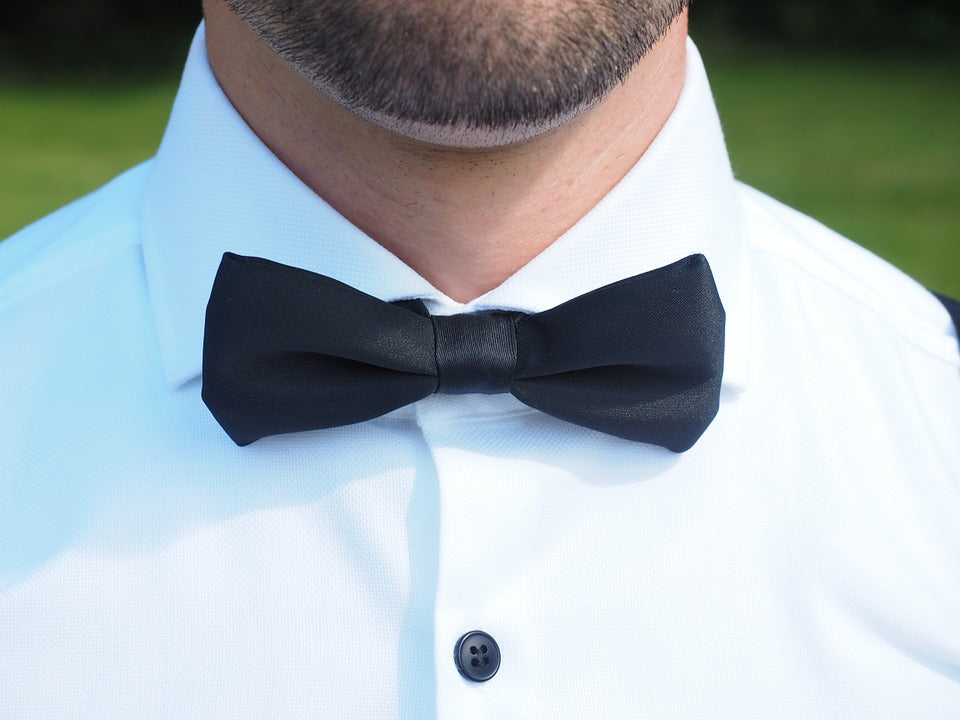Tuxedo: the Basics
Let's first go over the basic definition of the word "tuxedo," because this is a term that's still confusing to many people. A tuxedo is essentially a formal men's evening suit that is characterized by satin or grosgrain facing on the lapels and buttons, along with a stripe along the trouser's outseam. Most tuxedos are either black or dark blue; however, you can find them in just about any color. Tuxedos are typically worn with a button-up formal dress shirt, shoes, and a bow tie or necktie. Although they look similar in terms of appearance, there are a few stark differences between tuxedos and traditional suits. Among the most notable differences is the lapels. A suit's lapels are typically made of the same fabric as the jacket or coat. Tuxedo lapels, on the hand, are typically made of satin. Although subtle, the addition of satin lapels adds a new visual element of style to the tuxedo, enhancing the wearer's appearance. Tuxedo trousers also feature a strip of satin to match the lapels. In comparison, suit pants or trousers are made with the same fabric as the jacket. A final difference between tuxedos and suits is involves the tie. With traditional suits, long neckties are usually worn. But with tuxedos, a bow tie is typically worn. This doesn't necessarily mean that you have to wear a necktie with a suit and a bow tie with a tuxedo, but this is the preferred format for many men.Fabric Choices
If you've ever been shopping for a tuxedo before, you probably know just how many different fabrics there are available. Much like traditional suits, tuxedos are available in a wide variety of fabrics, ranging from traditional cotton and linen to wool and even velvet. All of the aforementioned characteristics remain the same with these different tuxedos. The only difference is the material from which they are constructed. So, what type of fabric works best for a tuxedo?Origins of the Tuxedo
You might be surprised to learn that tuxedos have roots dating back well over a century. According to Wikipedia, the rise of popularity surrounding outdoor activities among the British during the mid-19th century gave way for the tuxedo. Men wanted a lighter and more comfortable alternative to the evening tailcoat. The Prince of Wales was the first man on record to wear a tailless coat. It wasn't long before others began wearing them, and this paved the way for the modern-day tuxedo. In the U.S., a New York-based country club called Tuxedo Park became a style hub of sorts for the tuxedo. Many of its members began wearing tailless dress coats, which eventually evolved into the tuxedo. Today, the tuxedo has become a staple outfit worn by millions of men. 
Now that you know a little bit about tuxedos, you might be wondering how to wear one. Being that tuxedos are intended for formal occasions, the average man rarely finds the need to wear one. But when that time finally comes, it's important to follow some basic steps to create a stylish look that exemplifies all of the positive characteristics of the tuxedo. Here are some tips to follow when wearing a tuxedo:
- Get your tuxedo pressed before wearing it. I know this probably sounds like common sense to most people, but it's still worth mentioning that you should only wear a tuxedo after it has been pressed. Doing so eliminates wrinkles and creases, ensuring a clean and smooth appearance that reflects its formal style.
- Stick with lighter fabrics during the summer and heavier fabrics during the winter. With summer upon us, it's best to avoid wearing tuxedos (or any suit) made of thick fabrics. Instead, wait until the cool fall and winter months to wear a wool tuxedo. During the summer, stick with either a cotton or linen tuxedo. The lighter fabric will allow your skin to breathe more easily, keeping you cool and comfortable in the otherwise hot summer weather.
- Wear black dress shoes. There's a time and place for experimenting with bold-colored shoes, but formal events and occasions isn't one of them. When wearing a tuxedo, it's best to sport traditional black dress shoes. A pair of black leather oxfords, for instance, is an excellent choice that will compliment the rest of your outfit. Just remember to polish them with a bit of leather polish before heating out the door. This adds a touch of shine to your shoes, making them stand out with style.
- While you can always a rent a tuxedo, consider buying one instead. There will be occasions that call for a tuxedo, but you may struggle to rent one that fits just right. By ordering your tuxedo here at StudioSuits, however, you can specify your own measurements to ensure the perfect fit. It's a smart investment that will prove well worth the cost in the long run.
- Accessorize your tuxedo to create the perfect formal look. Some simple accessories that can make a world of difference in your appearance include a wristwatch, cufflinks and tie. These are the three "essential" accessories for a tuxedo, so don't forget them!
- Read, and follow, the instructions provided on the care label. Here, you'll find the manufacturers recommendations on how to wash, clean and care for your new tuxedo. Being that no two tuxedos are the same, care instructions will vary. This is why it's important to check the care label after buying a new tuxedo.



